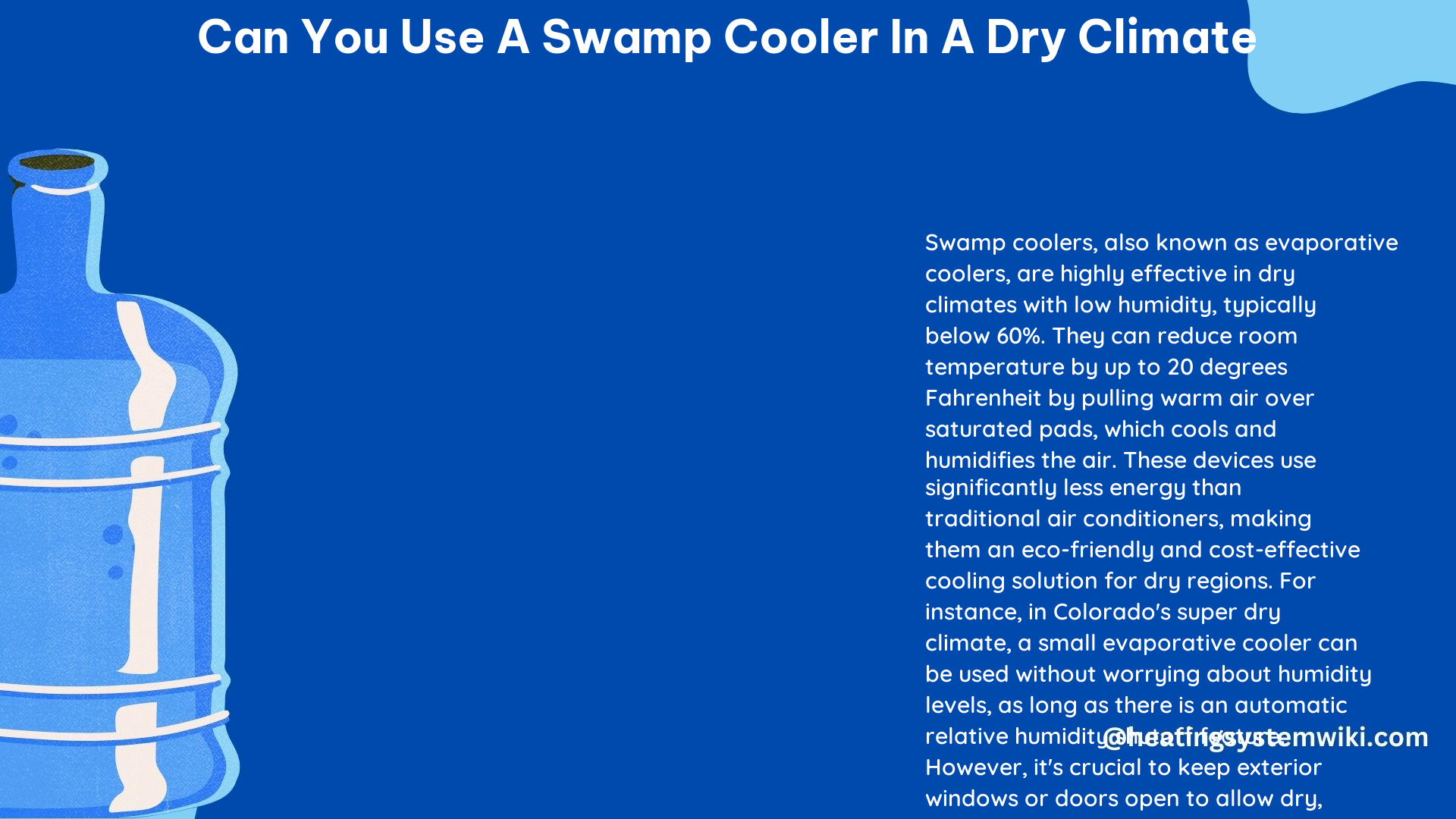Yes, you can use a swamp cooler in a dry climate. Swamp coolers, also known as evaporative coolers, are most effective in dry climates where the humidity is 60% or below. They work by pulling warm, stale air into the unit and passing it over moistened pads. As the air passes over the pads, the water evaporates, cooling the air and increasing its humidity. This cooled, humidified air is then distributed throughout the environment, reducing the ambient temperature often as much as 20 degrees Fahrenheit.
Understanding Swamp Coolers in Dry Climates
Swamp coolers are a popular choice for dry climates because they use significantly less energy than air conditioners, making them an affordable and eco-friendly cooling option. They are also easy to maintain, requiring only occasional cleaning of the reservoir and cooling pads.
Effectiveness of Swamp Coolers in Dry Climates
The effectiveness of a swamp cooler in a dry climate is directly related to the humidity level. According to the U.S. Geological Survey (USGS), evaporative coolers work best in areas where the humidity is 60% or below, which includes much of the western United States, including states like Arizona, New Mexico, and Nevada.
In these dry regions, the air has a low moisture content, allowing the water in the swamp cooler to evaporate more efficiently, resulting in greater cooling. The USGS reports that evaporative coolers can reduce the ambient temperature by as much as 20-40°F in these dry climates.
Maintaining Optimal Performance
When using a swamp cooler in a dry climate, it is important to keep exterior windows or doors open to allow for the exchange of dry, outside air with the moister, inside air. This will help prevent the humidity from rising too quickly and the cooler from becoming less effective.
To maintain optimal performance, it is recommended to:
- Monitor Humidity Levels: Keep a close eye on the humidity levels in the room or space being cooled. Aim to maintain a humidity level between 30-50% for best results.
- Adjust Water Flow: Adjust the water flow to the cooling pads as needed to maintain the desired humidity level. Too much water can lead to excessive humidity, while too little can reduce the cooling effect.
- Clean Regularly: Clean the reservoir and cooling pads regularly to prevent the buildup of mineral deposits and ensure efficient water evaporation.
- Ensure Proper Airflow: Make sure the swamp cooler is positioned to allow for proper airflow, with the fan blowing the cooled, humidified air into the desired space.
DIY Swamp Cooler for Dry Climates

To build your own swamp cooler in a dry climate, you will need the following materials:
| Material | Quantity |
|---|---|
| 5-gallon bucket or Styrofoam cooler | 1 |
| Electric fan | 1 |
| Water container or pump | 1 |
| Wick or aquarium tube | 1 |
| Basic tools for cutting | 1 set |
Step-by-Step Instructions
- Cut a hole in the top of the bucket or Styrofoam cooler for the fan to sit in.
- Place the fan in the hole, facing down.
- Attach the water container or pump to the fan.
- Place the wick or aquarium tube in the water container or pump, allowing it to reach the fan.
- Turn on the fan and add water to the container or pump.
- The fan will blow air through the wick or aquarium tube, causing the water to evaporate and cool the air.
- Place the swamp cooler in the desired location and enjoy the cool, humidified air.
Remember, it is important to keep exterior windows or doors open when using a swamp cooler to allow for the exchange of air and prevent the humidity from rising too quickly.
Conclusion
In summary, swamp coolers are an excellent choice for cooling in dry climates. They are energy-efficient, eco-friendly, and easy to maintain. By understanding the optimal conditions for their use and following best practices for maintenance, you can effectively use a swamp cooler to stay cool in a dry climate.
References:
- Sylvane. (2023-05-18). Stay cool this summer with a swamp cooler. Retrieved from https://www.sylvane.com/blog/stay-cool-this-summer-with-a-swamp-cooler/
- Reddit. (2020-07-22). How bad of an idea is an evaporative cooler in a dry climate? Retrieved from https://www.reddit.com/r/homelab/comments/hvvll0/how_bad_of_an_idea_is_an_evaporative_cooler_in_a/
- USGS. (n.d.). Evaporative coolers work best in the dry areas of the U.S. (Area A). Retrieved from https://www.usgs.gov/media/images/evaporative-coolers-work-best-dry-areas-us-area-a
